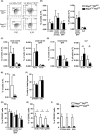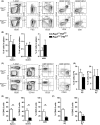Direct role of FLT3 in regulation of early lymphoid progenitors
- PMID: 30596405
- PMCID: PMC6492191
- DOI: 10.1111/bjh.15578
Direct role of FLT3 in regulation of early lymphoid progenitors
Abstract
Given that FLT3 expression is highly restricted on lymphoid progenitors, it is possible that the established role of FLT3 in the regulation of B and T lymphopoiesis reflects its high expression and role in regulation of lymphoid-primed multipotent progenitors (LMPPs) or common lymphoid progenitors (CLPs). We generated a Flt3 conditional knock-out (Flt3fl/fl) mouse model to address the direct role of FLT3 in regulation of lymphoid-restricted progenitors, subsequent to turning on Rag1 expression, as well as potentially ontogeny-specific roles in B and T lymphopoiesis. Our studies establish a prominent and direct role of FLT3, independently of the established role of FLT3 in regulation of LMPPs and CLPs, in regulation of fetal as well as adult early B cell progenitors, and the early thymic progenitors (ETPs) in adult mice but not in the fetus. Our findings highlight the potential benefit of targeting poor prognosis acute B-cell progenitor leukaemia and ETP leukaemia with recurrent FLT3 mutations using clinical FLT3 inhibitors.
Keywords: FLT3; conditional knock‐out mouse model; haematopoiesis; lymphoid development; lymphoid progenitors.
© 2018 The Authors. British Journal of Haematology published by British Society for Haematology and John Wiley & Sons Ltd.
Figures




Similar articles
-
Hoxa9 and Flt3 signaling synergistically regulate an early checkpoint in lymphopoiesis.J Immunol. 2013 Jul 15;191(2):745-54. doi: 10.4049/jimmunol.1203294. Epub 2013 Jun 14. J Immunol. 2013. PMID: 23772038 Free PMC article.
-
Threshold levels of Flt3-ligand are required for the generation and survival of lymphoid progenitors and B-cell precursors.Eur J Immunol. 2011 Feb;41(2):324-34. doi: 10.1002/eji.201040710. Eur J Immunol. 2011. PMID: 21268003 Free PMC article.
-
Critical role of FLT3 ligand in IL-7 receptor independent T lymphopoiesis and regulation of lymphoid-primed multipotent progenitors.Blood. 2007 Oct 15;110(8):2955-64. doi: 10.1182/blood-2006-10-054726. Epub 2007 May 31. Blood. 2007. PMID: 17540845
-
Flt3 Signaling in B Lymphocyte Development and Humoral Immunity.Int J Mol Sci. 2022 Jun 30;23(13):7289. doi: 10.3390/ijms23137289. Int J Mol Sci. 2022. PMID: 35806293 Free PMC article. Review.
-
NK Cell Precursors in Human Bone Marrow in Health and Inflammation.Front Immunol. 2019 Aug 28;10:2045. doi: 10.3389/fimmu.2019.02045. eCollection 2019. Front Immunol. 2019. PMID: 31555276 Free PMC article. Review.
Cited by
-
How Faithful Flt3-Cre Mouse is to Hematopoietic Lineage Tracing?Stem Cell Rev Rep. 2025 Jun 25. doi: 10.1007/s12015-025-10930-8. Online ahead of print. Stem Cell Rev Rep. 2025. PMID: 40555940 Review.
-
Neural Crest-Derived Mesenchymal Cells Support Thymic Reconstitution After Lethal Irradiation.Eur J Immunol. 2025 Jan;55(1):e202451305. doi: 10.1002/eji.202451305. Epub 2024 Nov 16. Eur J Immunol. 2025. PMID: 39548921 Free PMC article.
-
Pacritinib inhibits proliferation of primary effusion lymphoma cells and production of viral interleukin-6 induced cytokines.Sci Rep. 2024 Feb 19;14(1):4125. doi: 10.1038/s41598-024-54453-7. Sci Rep. 2024. PMID: 38374336 Free PMC article.
-
Specific Deletions of Chromosomes 3p, 5q, 13q, and 21q among Patients with G2 Grade of Non-Small Cell Lung Cancer.Int J Mol Sci. 2024 Aug 8;25(16):8642. doi: 10.3390/ijms25168642. Int J Mol Sci. 2024. PMID: 39201328 Free PMC article.
-
Risk assessment of FLT3 and PAX5 variants in B-acute lymphoblastic leukemia: a case-control study in a Pakistani cohort.PeerJ. 2019 Sep 10;7:e7195. doi: 10.7717/peerj.7195. eCollection 2019. PeerJ. 2019. PMID: 31565544 Free PMC article.
References
-
- Adolfsson, J. , Borge, O.J. , Bryder, D. , Theilgaard‐Monch, K. , Astrand‐Grundstrom, I. , Sitnicka, E. , Sasaki, Y. & Jacobsen, S.E. (2001) Upregulation of Flt3 expression within the bone marrow Lin(‐)Sca1(+)c‐kit(+) stem cell compartment is accompanied by loss of self‐renewal capacity. Immunity, 15, 659–669. - PubMed
-
- Adolfsson, J. , Mansson, R. , Buza‐Vidas, N. , Hultquist, A. , Liuba, K. , Jensen, C.T. , Bryder, D. , Yang, L. , Borge, O.J. , Thoren, L.A. , Anderson, K. , Sitnicka, E. , Sasaki, Y. , Sigvardsson, M. & Jacobsen, S.E. (2005) Identification of Flt3+ lympho‐myeloid stem cells lacking erythro‐megakaryocytic potential a revised road map for adult blood lineage commitment. Cell, 121, 295–306. - PubMed
-
- Almarza, E. , Segovia, J.C. , Guenechea, G. , Gomez, S.G. , Ramirez, A. & Bueren, J.A. (2004) Regulatory elements of the vav gene drive transgene expression in hematopoietic stem cells from adult mice. Experimental Hematology, 32, 360–364. - PubMed
-
- Armstrong, S.A. , Mabon, M.E. , Silverman, L.B. , Li, A. , Gribben, J.G. , Fox, E.A. , Sallan, S.E. & Korsmeyer, S.J. (2004) FLT3 mutations in childhood acute lymphoblastic leukemia. Blood, 103, 3544–3546. - PubMed
Publication types
MeSH terms
Substances
Grants and funding
LinkOut - more resources
Full Text Sources
Other Literature Sources
Molecular Biology Databases
Miscellaneous

